
Please send all Checks and Money orders to :
Dave Taylor P.O. Box 87 Sylvania, OH 43560
419-842-1863
Click Here to E-mail Us!
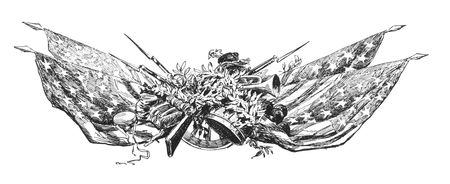
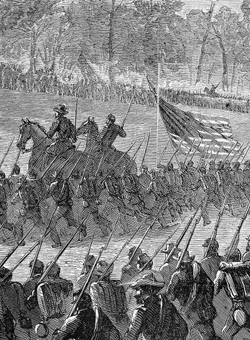
18-11-01
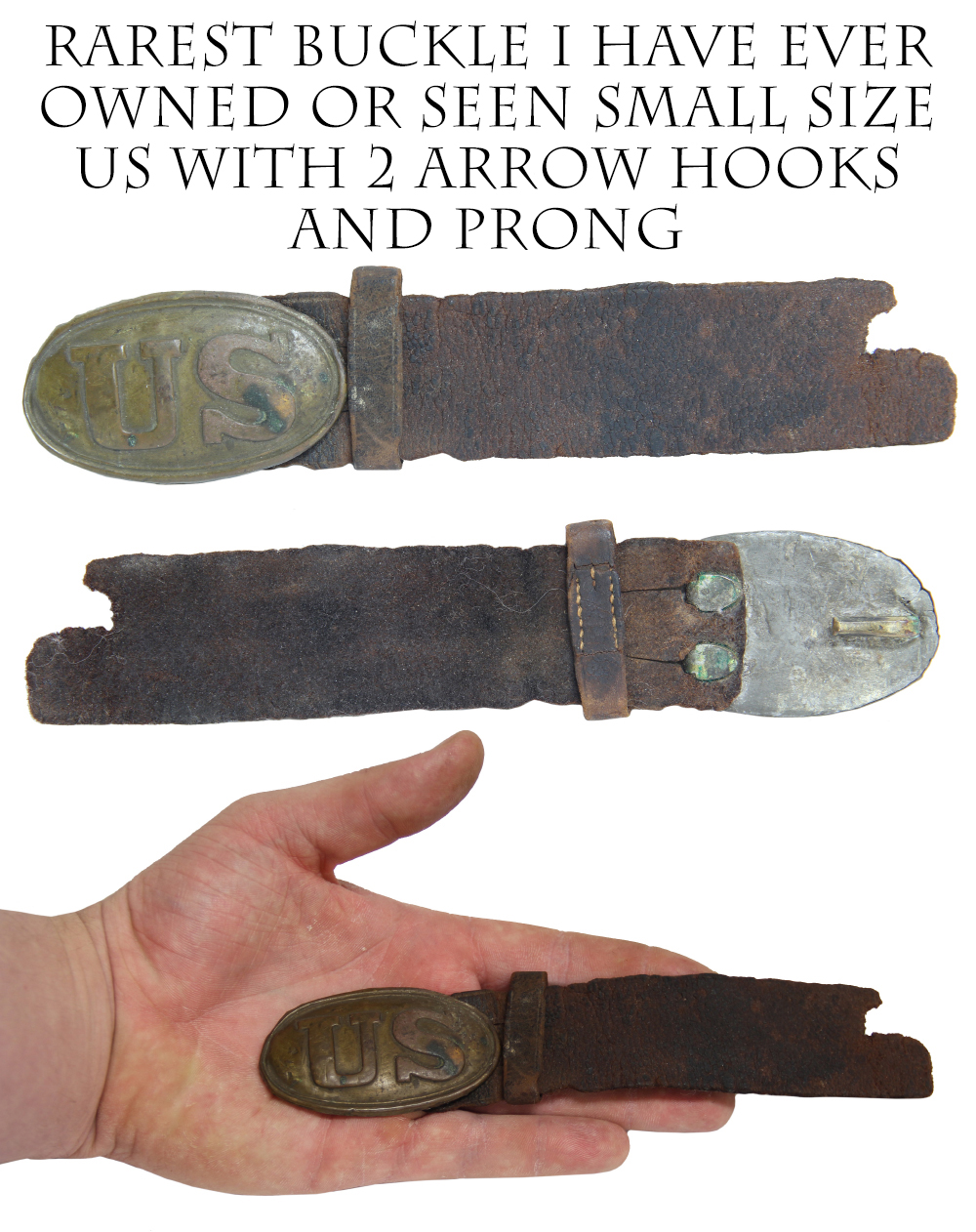
18-11-01 …RAREST SMALL US BUCKLE WITH PARTIAL BELT // OWNER K.I.A…
I have owned dozens of small US plates, and I have seen and handled hundreds of them. The small buckles ALWAYS either have a single brass arrow and single prong on the back or have iron wire bent into 2 hooks and a prong like on a three prong breastplate. Thats the only two attachments we ever see… ALWAYS ALWAYS ALWAYS. Until now… This is the first and ONLY example I have ever seen with two tiny arrow hooks and a prong, just like on standard large size buckles, but smaller. I have owned CS with stars buckles, I have owned a Freedom or Death 2pc CS buckle, a couple Alabama map buckles, one Arkansas buckle, one solid cast US oval… but this little US plate is rarer than any of those expensive treasures. I sent pictures to some fellow dealers asking if they had EVER seen a small US buckle with these hooks. Nope, not a one. To a man they were in agreement, this example is the only one any of us has seen. I am sure there are more out there… maybe this listing will bring one to light. The plate is non dug and attached to a fragment of belt. The patina is superb, untouched, and rich. There are a few small dings on the left edge of the plate near the hook, the hooks are firmly in place and the face of the plate is beautiful. The collector from whom I purchased this related that it had been sent home with the effects of Patrick Sheridan of Co. “C” 4th Rhode Island Vols after he was Killed in Action at New Berne, N.C. on March 14th 1862. I am not charging a penny for the history… just passing it along. It is difficult to price something like this. I will use the solid cast US buckle as the barometer even though this small US is rarer…
$1,600.00
sold
Call us @ 419-842-1863
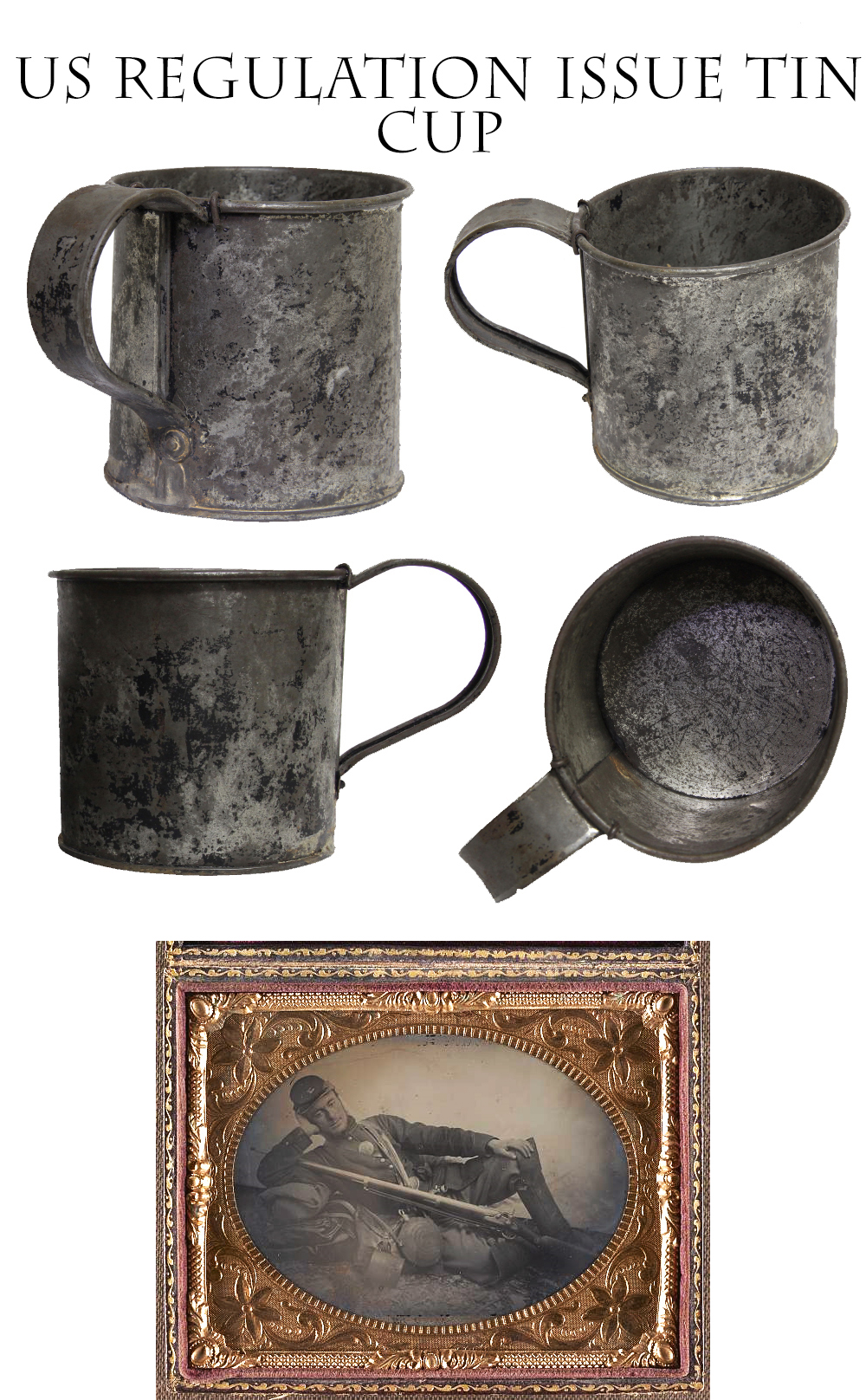
18-11-02 …US REGULATION ISSUE TIN CUP …
Mess gear was issued by the recruiting services, which were controlled by the states early in the war and there are thus a number of different patterns of utensils that are “issue.” These 4 by 4-inch tinned iron cups were the pattern issued most widely by the US government during the Civil War. They hold one quart of liquid when filled to the top. The seams are crimped to make them watertight and the handles are secured with heavy wire rolled over the rim at the top lip. The handle also has a rivet at the bottom. They are heavy duty to make sure they do not come apart over a hot campfire. These were so utilitarian after the war that they are very tough to find in soldier’s effects passed down through the family. When I was a kid there were some very few still available as surplus from the old Bannerman stock. They were $5 and $6, but were hard to find at gun shows. Only a few of the old timer dealers had them in any quantity. And back then you had to wait weeks or months for the next gun show, and hope that one of the old timers would show up with some Bannerman surplus. If he did it felt like Christmas! This one is nice aged gray metal with splotches of black paint or black carbon. Along with the haversack and canteen the cup was an essential piece of a soldier’s gear in camp and occasionally on the battlefield, where they were often rushed into service to help scoop out rifle pits. Very difficult to find these days… and watch out for reenactor replicas that have been used for decades. (The reenactor cups are much lighter weight than the real ones.) A very nice original CW issue cup…
$265.00
sold
Call us @ 419-842-1863

18-11-03 …MINTY COOPER REVOLVER …
A really, really fine second model Cooper Navy revolver. Matching serial number 1862. Loads of beautiful thinning blue on the barrel and aft part of the rebated cylinder. Some brown speckling coming up from underneath on the fore part of the cylinder and barrel flats. Blue still showing on the screw heads and a mix of blue and gray on the frame. Tight wood to metal fit. Dings on the bottom of the butt and scattered wear to the sides of the grips, but with very nice color. Correct three-line Philadelphia markings. These double-action .36 caliber revolvers are sometimes considered secondary martials because of the caliber. No government contracts have turned up, but they are typical of an officers privately purchased side arm. With a production run of some 15,000 from 1864-1869, this is almost certainly a wartime gun but would look great in an early western display and holds its own for condition in any pistol collection.
$1,375.00
hje sold
Call us @ 419-842-1863
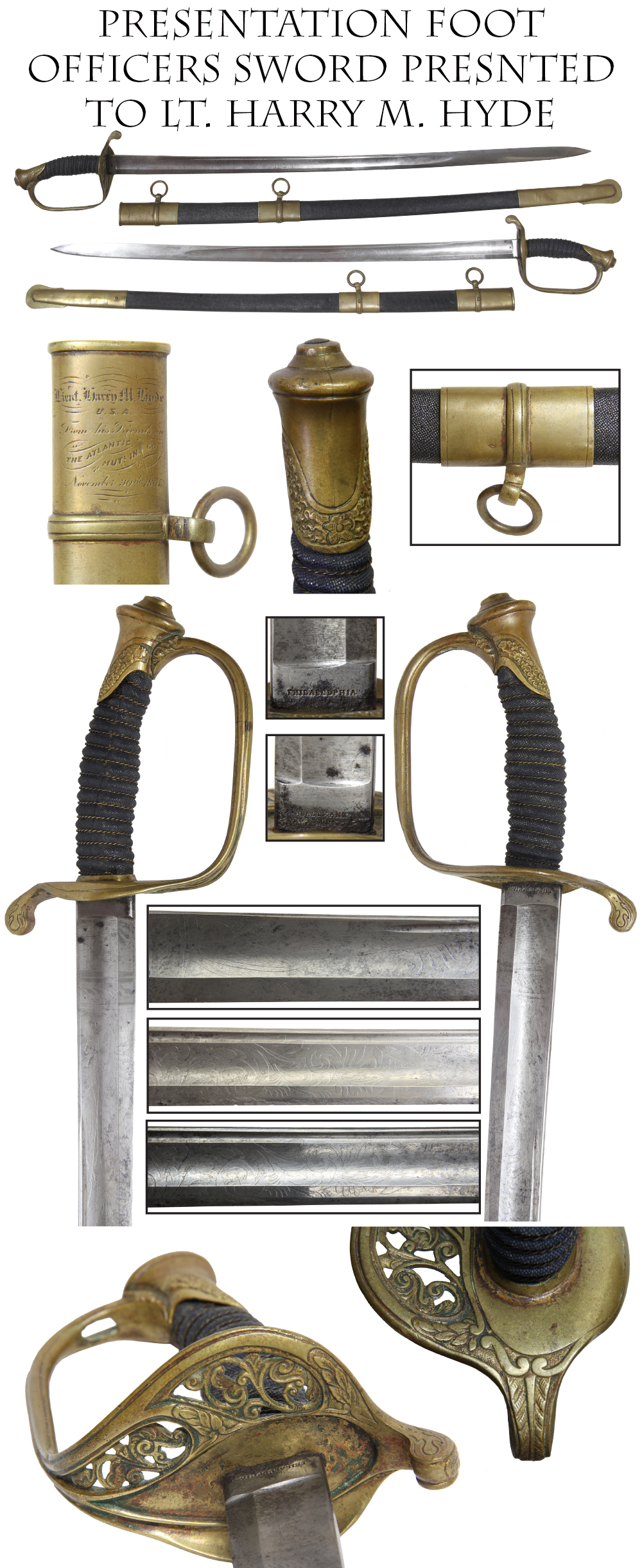
18-11-04… FOOT OFFICERS SWORD PRESENTED TO LT. HARRY M. HYDE, 14th BROOKLYN THEN COMMISSONED IN THE 5th US CAVALRY – THEN SERVED IN THE NAVY UNTIL HIS DEATH IN 1864…
Regulation US Model 1850 Foot Officers Sword by Horstmann, with a great presentation on the upper mount: Lieut. Harry M. Hyde / U.S.A./ From his Friends in / The Atlantic Mutl. Ins. Co. / November 30th 1861. The blade is bright, with visible etched floral motifs with just light graying and a few brown spots near the ricasso. The scabbard is a high grade version with sharkskin body rather than leather. The brass mounts and hilt have a matching medium patina. The grip retains its full sharkskin wrap as well, along with its twisted wire binding. Horstmann is stamped on one side of the blade at the ricasso and Philadelphia on the other. The blade retains a good edge and point and the hilt and blade are tight. The presentation reflects the recent commissioning of Henry (Harry) Martyn Hyde in the US regular army as a lieutenant in the 5th US Cavalry. His friends in the insurance business obviously did not fully understand the differences in infantry versus cavalry blades, but knew he was going into the regulars: hence the USA in the inscription for United States Army. Hyde had just seen hard service in the famed 14th Brooklyn. Enlisting as a private at age 27 on 4/18/61 in Brooklyn, he was mustered into Co. C on 5/23/61 and served with the regiment until 11/12/61. During this period the regiment, designated also as the 84th New York, served in the Army of the Potomac and was heavily engaged at First Bull Run, losing 2 officers and 30 enlisted men killed, another 14 enlisted men who were mortally wounded, and 4 officers and 30 enlisted men who were wounded but recovered, as well as 62 officers and men captured or missing. Hyde was made corporal in the company at some point, but was destined for higher rank. He was discharged from the New York regiment dating to 11/12/61 to enable him to take a commission as 2nd Lieutenant in the 5th US Cavalry, the reorganized and redesignated 2nd US Cavalry, just back from frontier service. Hydes commission dated to 10/24/61 and it was in honor of this commission that his friends in the Atlantic Mutual Insurance Company pitched in and presented him with this sword a month later. Hydes service in the U.S. Army sadly was not to be long. He showed up drunk at the HQ of the 5th US Cavalry, asked for a favor, was denied his request, and so he elected not to accept his commission. Records show he was dropped from the rolls of the 5th Cavalry on 12/14/61. Then in early 1862 he was appointed a Paymaster in the US Navy, presumably at the Brooklyn Navy Yard. He is mentioned in the Brooklyn newspapers on a few occasions between 1861 and 1864. He got married and then died in early 1864. I will let you research the cause of death. I don’t know what killed him, but I know he left behind one darn nice presentation sword that spoke well of the esteem in which his friends held him.
$1,950.00
zxaezxsaus
Call us @ 419-842-1863
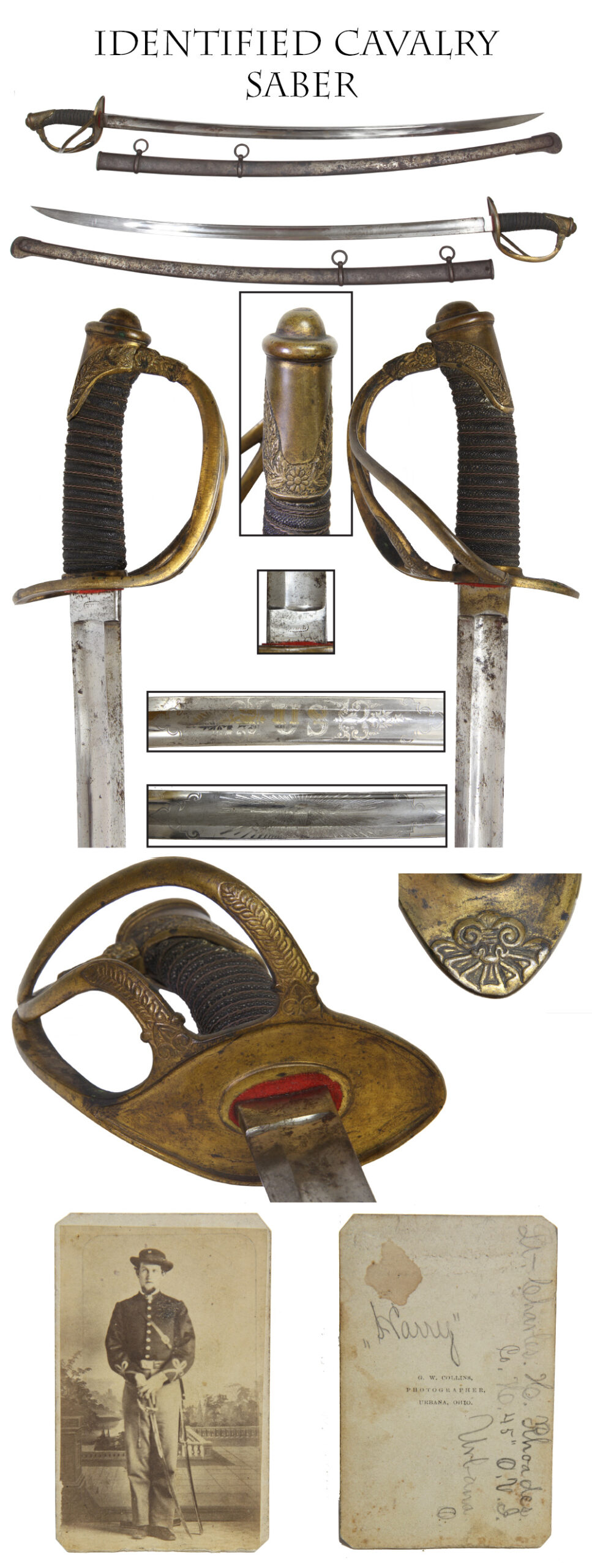
18-11-05…IDENTIFIED CAVALRY OFFICER’S SABER…
A good friend of mine purchased this sword and several CDV photos directly from the descendants of the Civil War soldiers in the Rhode’s family of Urbana, Ohio. He sold me several of the photos a couple years ago but kept this cdv and saber until recently. The photo is a CDV by Collins of Urbana, Ohio showing Charles Rhoades full standing in a studio with this saber at parade rest- held point down to the ground in front of him. There is enough detail to show it is this same cavalry saber. The etched panel part way down the blade is distinctly visible. Our man wears a short officer’s jacket with galloons at the cuffs, an officer’s sword belt with shoulder sling, and a narrow-brim non-regulation hat that shows a two-digit number on the upper front. On the reverse in period pencil is “Lt. Charles H. Rhoades/ Co. K 45” O.V.I. / Urbanna, O.” and “Harry,” obviously the familiar middle name by which he was known to his friends. Rhoades, often spelled Rhodes in the records, shows up as enlisting in the 45th Ohio as a private at age 22 in Urbana, Ohio, on 8/4/62 and mustering into Co. H, commanded by his father, William Rhodes, on 8/19/62. The Ohio roster does not give the date or method of his discharge, but notes that he was detached at some point to act as a clerk in the Quartermaster Department of the 1st Division of the Cavalry Corps. In November 1863 the regiment was upgraded to mounted infantry and assigned to the cavalry corps of the Army of the Ohio. This explains the horseman’s saber. During the period Rhoades was with the 45th they saw action in a number of engagements in Kentucky and Tennessee, including Duttons Hill, Monticello, and several fights at Philadelphia, including one in October, 1863, when they suffered 4 killed, 12 wounded and a large number captured. Rhoades had prior service as an officer in the 66th Ohio, which organized at Urbana in 1861. Charles H. Rhodes, then 21 years old, enlisted as a private on 10/8/61 and was promoted to 2nd Lieutenant on 12/14/61. In January, 1862, the regiment was sent to West Virginia and saw action in the Shenandoah Valley. Lt. Rhodes was discharged for disability 2/28/1862. He went home to recuperate and then reenlisted in the army when his father organized a company for the 45th. The saber is a regulation 1860 pattern cavalry officer’s saber. Overall very good condition. The sharkskin grip wrap is about perfect. The red cloth pad at blade shoulder is present and the “P.D.L.” German blade maker mark is legible. Best of all, the blade is near fine condition… in the bright, with a vivid etched panel on either side several inches down from the ricasso that is clearly evident in the photograph. The US and spreadwing eagle etched panels even retain some of their original frosting. The edge and point are good. There is just some scattered gray and brown age spotting. The plain scabbard shows a mix of steel gray and dull gray mixed with brown spots. The hilt has a very nice muted, aged patina that shows a few spots of the original gilt finish. This is a handsome identified horseman’s saber straight from the family, with a photo of the soldier holding it. There is a lot of interesting Rhoades family history to research. Ask me about the related CDV I kept for my collection.
$2,150.00.
xafxt sold
Call us @ 419-842-1863

18-11-06….1862 DATED MODEL 1861 SPRINGFIELD
The Model 1861 Rifle Musket is the classic long arm of the Civil War, in heavy demand by soldiers at the time and by collectors ever since. Finding one dated in the first two years of the war is a tough task. This 1862 dated example is in overall good condition and shows honest field use with some rounded corners to the wood from handling and light dings and scratches overall. Lock markings are clear, visible barrel proofs, barrel date is gone, ink inspector cartouches visible on the off-side wood. Mechanics are good. Bore is shot out with only vestiges of rifling remaining. Bolster shows some firing corrosion and there is some burnout to the wood just behind the nipple, both signs of active field use. Iron mounts are good and show a silver gray. Barrel is a bit darker, but generally smooth metal throughout. Bands, springs and swivels are in place. Sights are in place, though the rear sight is missing the lower leaf. A previous owner polished the barrel bands and the breech plug tang. Who knows why. The ramrod is an incorrect replacement that should be swapped out. A good example of the quintessential Civil War infantry rifle musket. A nice wall hanger or reenactor gun.
$950.00
xhejx jpal sold
Call us @ 419-842-1863
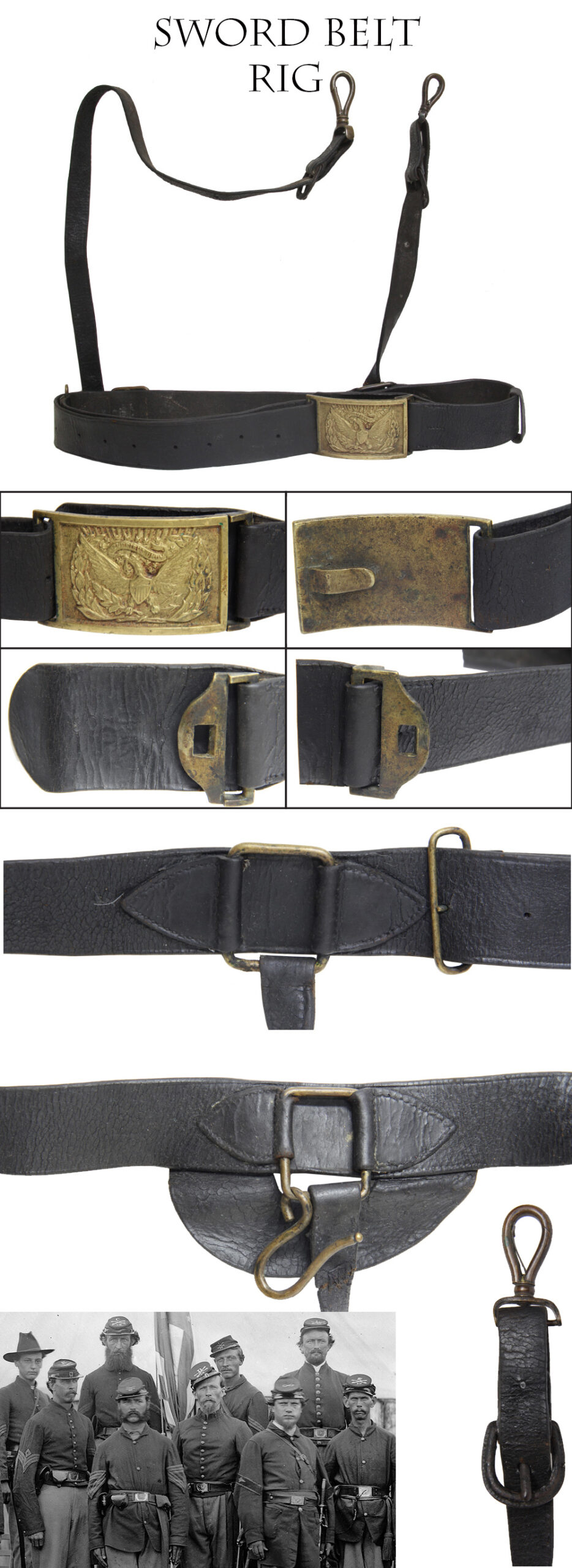
18-11-07 … GOOD SOLID OFFICER’S SWORD BELT RIG:
A really solid Civil War officers sword belt. These usually show up in fancy folded thin leather, this one is made of hearty black bridle leather, which is far more robust and better suited for field use. The plate is the regulation 1851 pattern rectangular eagle sword belt plate for the commercial market (where officers had to purchase their gear) that matches the hasp, has a correct integral cast wreath, and shows good die work and the early narrow tongue. The belt adjusts for size by a brass wire buckle fixed on one end and the sword slings are attached by pointed end leather billets securing square loops that could be used to secure a shoulder belt if the officer decided to use one. The semicircular “safe” behind the forward sling and the rectangular safe behind the hasp are both in place. Excellent condition overall with good finish and solid, with just a small repair where the hanger strap joins the belt. The slings adjust in length using iron horseshoe shaped buckles, and each hanger strap is fitted with a snap swivel. A top notch example of an officers belt specifically designed for field service.
$795.00
xfejxwtr sold
Call us @ 419-842-1863
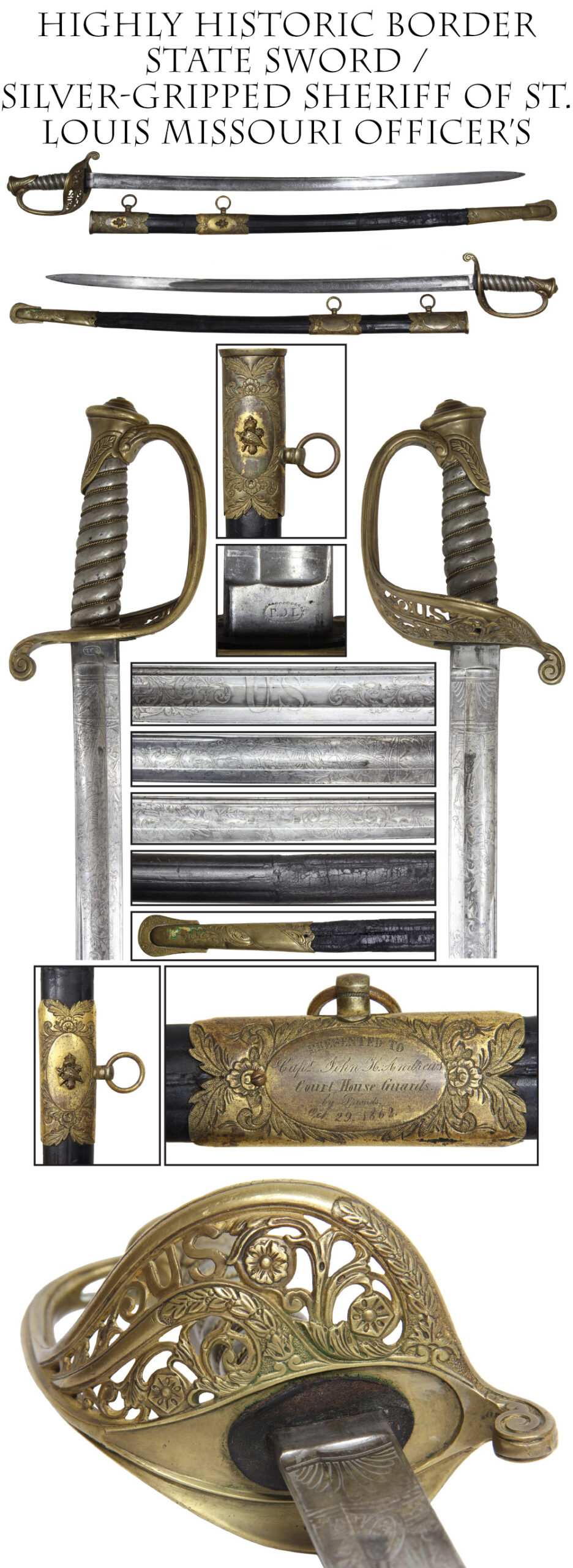
18-11-08… HIGHLY HISTORIC BORDER STATE SWORD / SILVER-GRIPPED SHERIFF OF ST. LOUIS MISSOURI OFFICER’S PRESENTATION SWORD:
Probably no state was contended for more savagely by both north and south than Missouri. The state was ravaged by armies, raiders, guerillas, bushwackers, and militia from both sides. It suffered from warfare, war crimes, horrible violence and retribution. Like the rest of the state, St. Louis was divided in sentiment, but it effectively remained under Union control. Here is a high quality and fancy 1850 pattern officer’s sword presented to none other than Sheriff John H. Adams of St. Louis when he assumed command of the “Court House Guards,” a militia company organized in 1862 that was composed largely of city and county officials. Bearing the “P.D.L” maker’s stamp of Peter D. Lunenschloss at the ricasso, the sword is a high grade 1850 pattern officer’s sword that has the branches of a foot officer’s pattern, but also the letters “US” incorporated in the guard as seen of staff swords. It also has a fancy cast silver handle. The blade is very good, with vivid floral scroll etching on both sides, along with a “U.S.” and an American eagle with an E Pluribus Unum ribband over head. The blade has a good edge and point. There is a small repair to a slight crack in the leather between the top and middle mount. When found the bottom eight inches of the sheath and the drag were missing. I had these restored using ORIGINAL parts robbed from another original sword. The resulting restoration is excellent. The silver grip is very good, with no dents or damage and the brass binding wires running in the spiral groove are still in place. The brass hilt and brass mounts have a beautiful matching mellow patina with traces of gilt. The mounts are profusely engraved and each of the upper two bears a small trophy of arms in relief. Interestingly, it is the middle mount that bears the presentation inscription: “Presented to / Capt. John H. Andrews / Court House Guards / by Friends / Oct. 29, 1862.” According to a local history, the company was sworn into Federal service but then remained in state service. The sheriff held drills for his men in the rotunda of the city Court House, which served as a reminder to the local populace who was in control. Sheriff Andrews, however, had one incident that showed the difficulties of performing his civic duty in a divided city under martial law. When Union refugees from outlying districts flooded the city, loyal citizens made contributions to help support them and Gen. Halleck levied goods and money from suspected southern leaning citizens to match. Sheriff Andrews actually found himself in the unenviable position of trying to enforce a court order to restore seized property while being blocked by U.S. troops. Such were the complicated politics of the time. In terms of Saint Louis history, this is a very cool item. It should probably be in a museum in that city. A high grade presentation sword given to a civic leader that really represents a city, state, and country split apart.
$4,850.00
Call us @ 419-842-1863
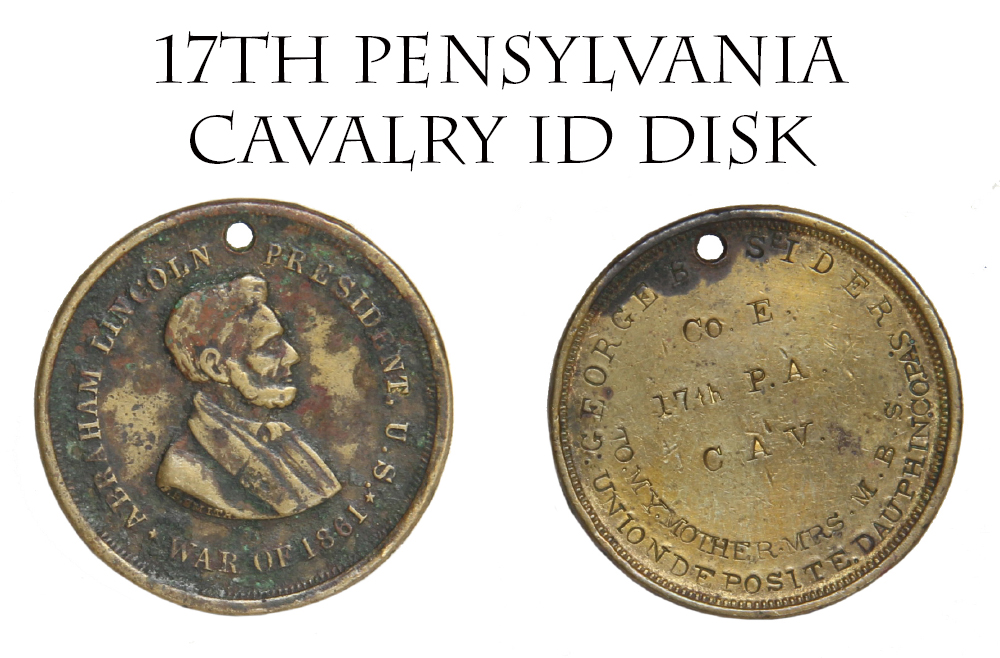
18-11-09 … 17th PENNSYLVANIA CAVALRY ID DISK:
Since the government supplied no “dog tags” soldiers had to privately purchase ID discs or pins/badges with their own money. This is a very desirable pattern made by one of the Scovill companies with a bust of President Lincoln on one side, around which in raised letters reads, “Abraham Lincoln President U.S. / War of 1861” Collectable in the arena of Lincolniana as well as Civil War antiques. On the other side of the planchet the soldier had stamped his own name, unit, and hometown, and also the name and address of his mother so that it could be sent to her should he be killed on the battlefield. Stamped in an arc along the top is, “GEORGE B. SEIDERS,” and along the bottom: “UNION DEPOSITE DAUPHIN CO PA” Seiders’s unit is stamped in the middle: Co. E / 17th/ P.A. CAV.” Below that is, “TO MY MOTHER MRS. M.B.S.” George Seiders was born in 1829, was married, and lived in Lebanon when he enlisted and mustered into Co. E of the 17th PA cavalry on 9/19/1862. His mother, Margaret, born about 1795, lived in Union Deposit, an unincorporated community in Dauphin County, near Harrisburg, and it is her address that is on the disk. Seiders served for about a year, being transferred to the Veteran Reserve Corps on 9/6/63 and serving with them until muster out on 6/9/65. During this period the 17th PVC served in the Army of the Potomac in Devin’s 2nd Brigade of Buford’s 1st Division, seeing action and taking losses at Occoquan, Chancellorsville, Brandy Station, Aldie, Gettysburg, Funkstown, and Falling Waters. I am unable to determine if Seiders was at Gettysburg… his subsequent assignment in the VRC tells me he was wounded or taken sick sometime before September… but thus far I cannot determine which it was or when. CWData lists Seiders as “Siders,” but his pension and services cards list his name as spelled on the disk. The disk does give his middle initial as “B” instead of his real initial, “P,” but this is likely a mistake made by the sutler who took Seiders’ order while trolling the military camps for customers. I like the addition of his mother’s name and address to the disk. Fortunately for her, he made it home, living until 1912……
$875.00
xzejjqq sold
Call us @ 419-842-1863
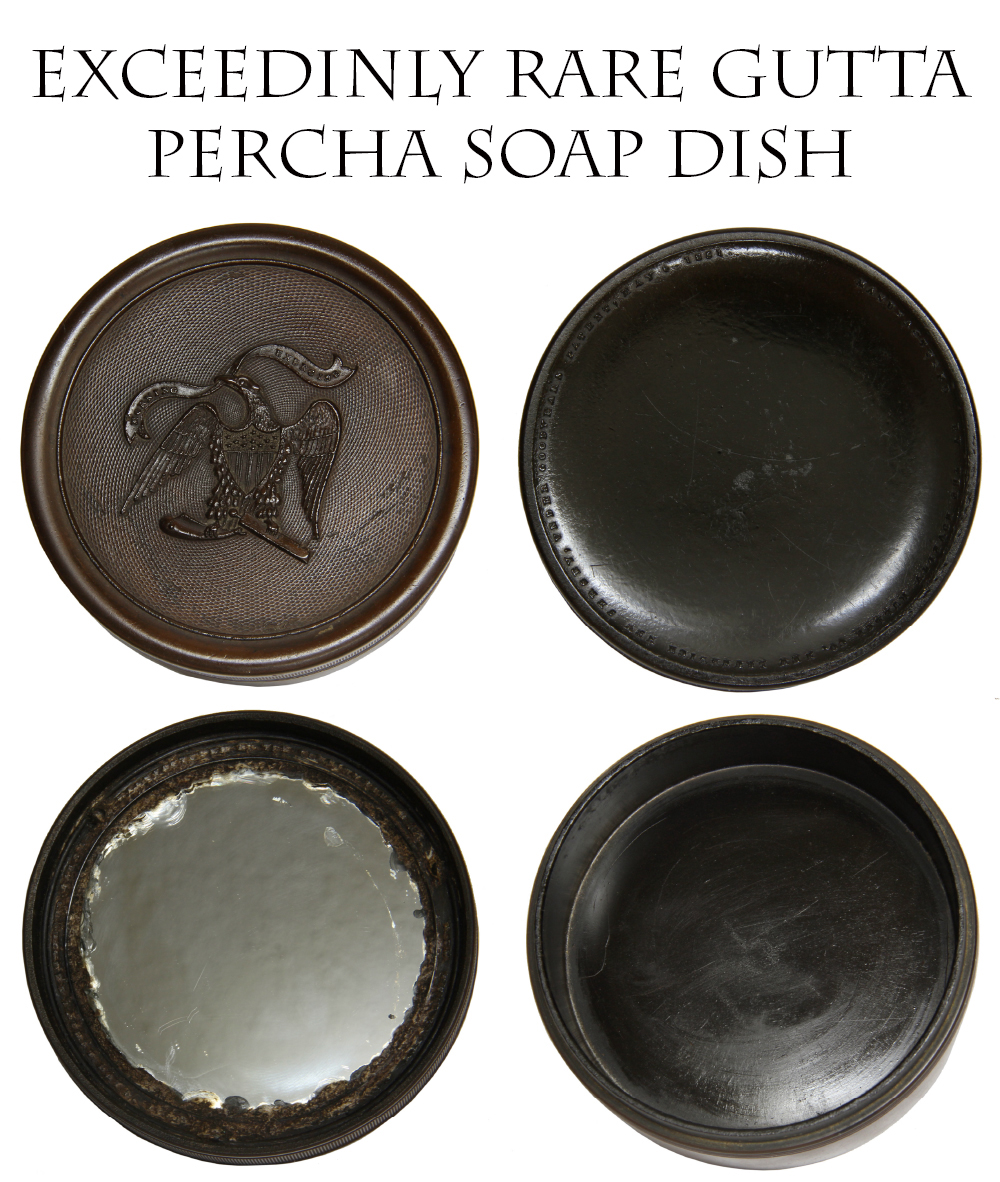
18-11-10 … EXCEEDINGLY RARE GUTTA PERCHA SOAP DISH…
Collectors are familiar with the thermoplastic shaving soap dishes with a USN / Anchor motif and “Don’t Give Up the Ship” motto. Here is one that is a hundred times rarer that is the army version. It portrays a spreadwinged American eagle with a US shield on its chest, holding a ribband in its beak reading “MORNING EXERCISE” and clutching, instead of olive branch and arrows, a closed razor and sharpening strop. This has wonderful condition and is complete with its mirror intact inside and the usual patent information around the inner edge. Some minor deterioriation around the periphery of the mirror and some grunge, but very nice, and extremely rare. You will turn up a hundred of the navy versions before you find one of these. … On Nov. 21st, 2008 (ten years ago) one of these sold at Heritage Auction for $1,912.00 including the buyer’s premium and that one had a cracked mirror!!! (You can verify this on their web page. Lot 57942 ) I sold a better condition example for $1295 a couple years ago. One of the rarest of Civil War personal items. Priced as gently as I can…
$850.00
sold
Call us @ 419-842-1863
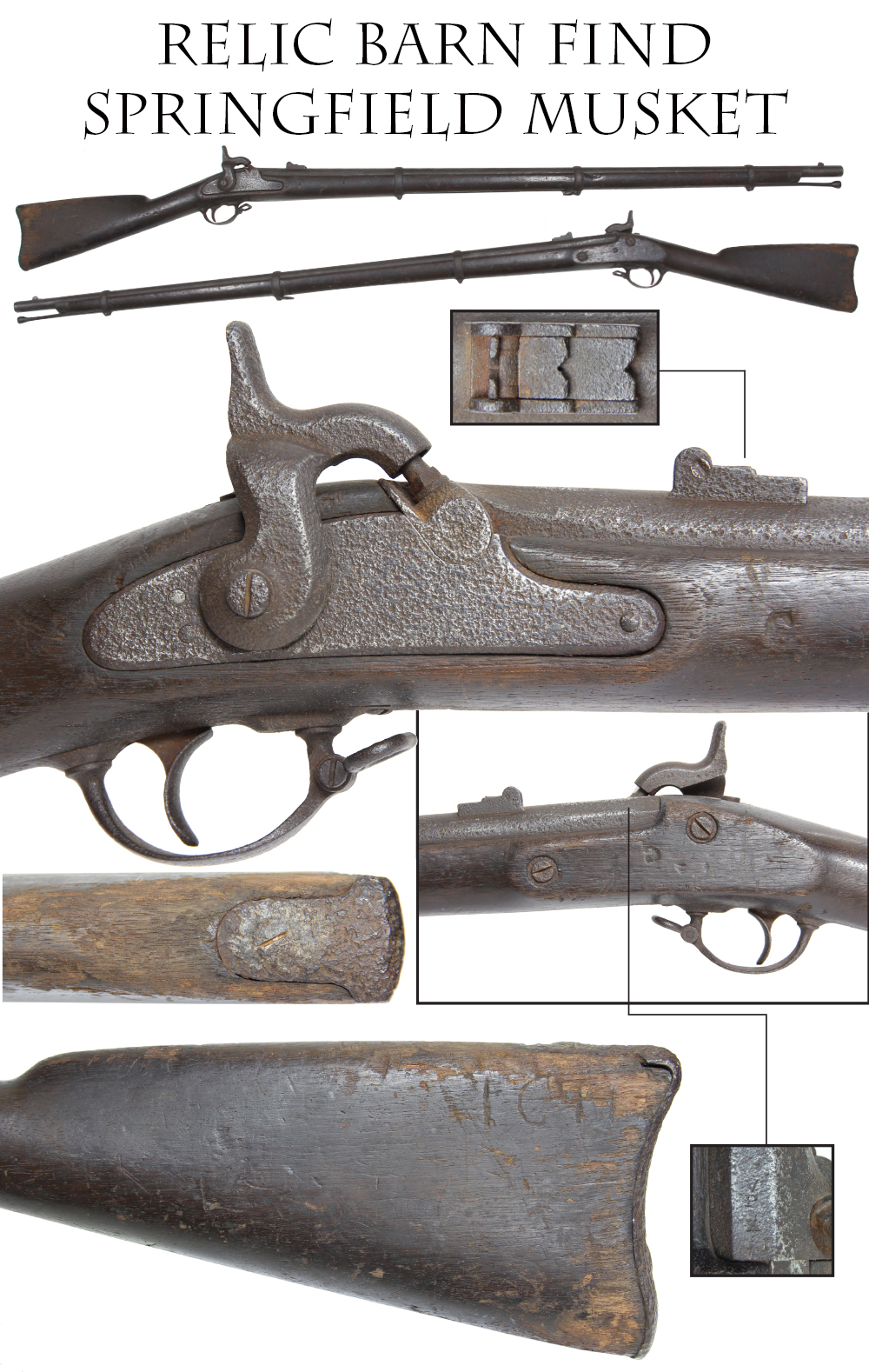
18-11-11… RELIC BARN FIND SPRINGFIELD MUSKET:
Barn finds don’t happen much any more, but they are interesting when they do. There is a special feeling of holding history in your hand when a relic sword or musket like this turns up that was brought home and left uncared for, undisturbed, and forgotten for generations. I like to imagine some 1800s farm boy finding it at Gettysburg or Antietam and putting it in the barn… A worthless relic like all the other worthless rusty relics they have found and stored in the barn. As is to be expected, the metal shows deep pitting overall, especially on the buttplate, lock, rear sight and lower barrel, yet some markings are visible. The V/P/eaglehead barrel proofs are legible and on the upper left butt flat part of the soldier’s carved initials remain even though the wood has suffered some abrasion. The lockplate is not readable, but the rifle is an 1863 Type 1 rifle musket made with the solid barrel bands without band springs, the recurved hammer, etc., that identify this pattern. The sights, bands, swivels and ramrod are in place. Aside from some discoloration along the top of the butt near the buttplate and some abrasion, the wood is pretty good. Guns in this 100% complete relic condition are much rarer than VG condition guns… and these have more character. This should never be cleaned or oiled…. It’s a superb relic as it stands. ….
$650.00
sold
Call us @ 419-842-1863

18-11-12 … BEAUTIFUL HIGH GRADE ENGLISH PERCUSSION BELT PISTOL…
Ca 1845-1850 German silver mounts, inlaid silver and gold bands at the breech of the blued 6 inch barrel, floral engraving and excellent checkered wood grips make this a very, very appealing percussion pistol. The barrel is nicely plum patinated. Screw heads, trigger guard, breech and breech plug tang all show matching floral engraving. The butt cap has a small compartment for percussion caps that has a floral sunburst on its lid. The back action lock is marked “Parker” and the barrel is engraved “London.” Hinged captured ramrod assembly is in place. The breech and nipple are excellent, with no corrosion. The action is good. A small oval silver escutcheon, unengraved, is on the wrist, like the other mounts, of German silver. This is an elegant gentleman’s pistol in stellar condition…. $1,150.00 sold
Call us @ 419-842-1863
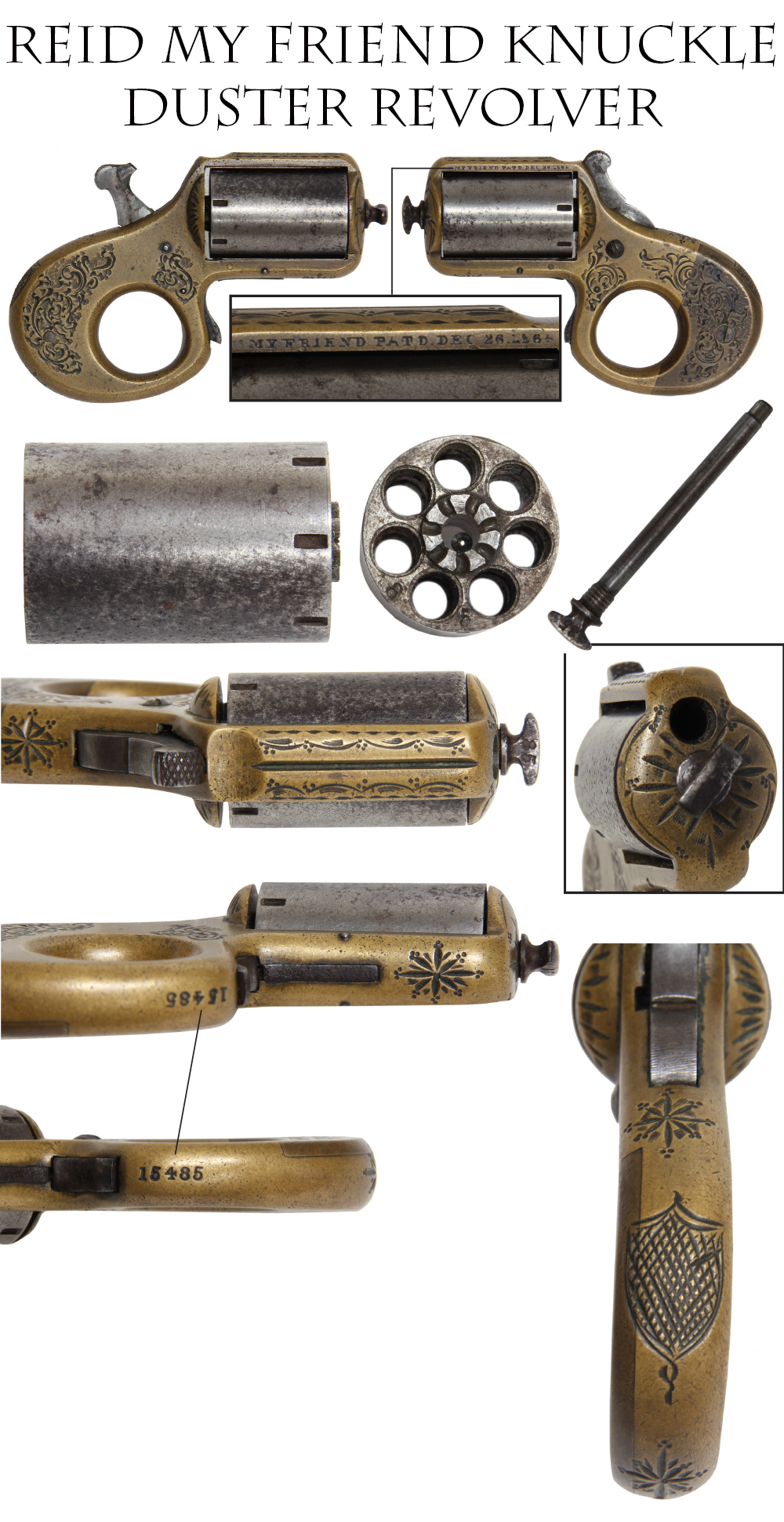
18-11-13 … REID “MY FRIEND” KNUCKLE-DUSTER REVOLVER:
These seven-shot .22 caliber revolvers were made for close-in work. If seven shots could not bring an opponent over to your way of thinking, the frame would serve as a set of brass knuckles to put a finer point on your position. Reid made 10,690 of this pattern according to Flayderman, and it was his best-seller, making up about half of his overall sales from about 1868 to 1872. The brass frame was originally silver plated, and like most examples this has worn off, but it has left an even mellow brass patina with broad floral engraving on the sides and geometric/floral motifs on the top, bottom, front and back, including a checkered shield on the backstrap— Reid’s engraving patterns show lots of variations. At top of the frame on the left side is Reid’s “MY FRIEND” logo along with his Dec. 26, 1865 patent date. The cylinder shows some roughness on one side, but blends in well with a mix of bright and darker gray, and matches the serial number of the pistol, showing the last two digits of the 15485 serial number stamped on the underside of the frame. A key pistol for a derringer or early western collection that would look great displayed with a poker hand. A real conversation piece and a wonderful curiosa….
$1,350.00
zxajjjxz sold
Call us @ 419-842-1863
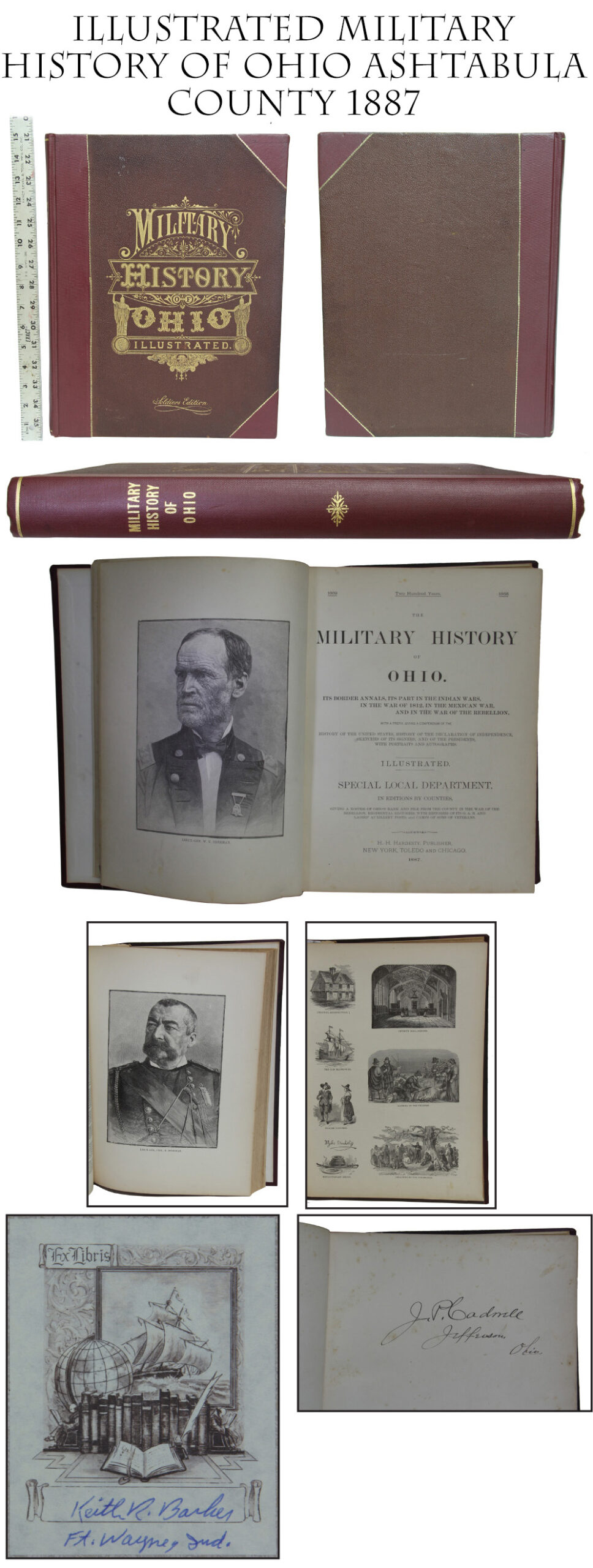
18-11-14 … ILLUSTRATED MILITARY HISTORY OF OHIO ASHTABULA COUNTY 1887…
These books were issued on a county by county basis. This volume covers the military history from NE Ohio in Ashtabula county. , including the early Indian Wars, War of 1812, Mexican War and the Civil War. It is probably no coincidence that this book was published in time for the 25th anniversary of the Civil War. Nice illustrations and good information. This has a previous owner’s bookplate mounted in it, but also bears the original owner’s name in ink: “J.P. Cadwell / Jefferson / Ohio” who is likely John P. Cadwell, who served in the 86th Ohio in 1863 and 1864, and in the 182nd Ohio in 1864 and 1865. Excellent condition with restored spine. $175.00 sold
Call us @ 419-842-1863

18-11-15 … 1864 SPRINGFIELD RIFLE MUSKET…
The regulation Union infantryman’s longarm as produced at the national armory in Springfield: the .58 caliber, single shot, muzzle-loading rifle of musket length. Introduced with improvements upon the 1861 and 1863 type 1, this rifle musket uses a recurved, beveled hammer, rounded bands with retaining band springs, a straight ramrod, improved sight, and a bolster without a clean-out screw, etc. The mechanics on this one are good. The lock markings are clear. The V/P/eagle barrel proofs are legible. The eagle on the bolster is crisp is distinct and there is very little corrosion around the nipple, just a small bit of burnout to the wood aft of it, indicating the gun has seen action, but was cared for. There are the usual dings and abrasions to the wood and someone put a tack in the left flat of the butt stock for some reason. There is slight rounding to the edges of the wood from honest use, and a few dings on the left barrel flat at the breech from removing the breechplug to clean it. A very respectable veteran of the war. Bands, springs, sights and rod are in place. The swivels are missing, but easily replaced if you want to. A nice looking 1864 Springfield at a price that won’t break the bank. .
$895.00
xbuninqz sold
Call us @ 419-842-1863

18-11-16 … SUPERB AMERICAN EAGLE HEAD SWORD:
I am always taken with these War of 1812 period eagle head officer’s sabers. This one is long enough to serve a mounted officer and the silver wash remaining on the scabbard mounts indicate he may have commanded an infantry unit, though silver was also the branch of service color for dragoons. The checkered bone grip is excellent, with no cracks or chips. The reverse-P guard and eaglehead show a mellow brass for the most part, the ferrules and langets still have some silver wash remaining. The blade shows a vivid blue for almost the whole upper half of the blade, terminating in flame and floral swirls, which sets off the gilded engraved motifs on either side. The lower portions of the blade are a clean, silver gray, and the blade has a good edge and point. The upper portions near the ricasso show a bit of gray and brown from the iron portion of the blade and tang, but the gilt is strong even there and the color transitions well into the vivid blue just below. The scabbard is black leather, solid, and has all three mounts, the throat having both an upper carrying ring for saber slings and a button for frog if the officer chose that method of attachment to his belt. There is one spot about halfway between the lower mounts that indicates an old break was repaired, but it is well done, blends in, and I would leave it alone. A very showy sword and doubly impressive with the white mounts for the scabbard……
$1,150.00
xzhjjqqw sold
Call us @ 419-842-1863
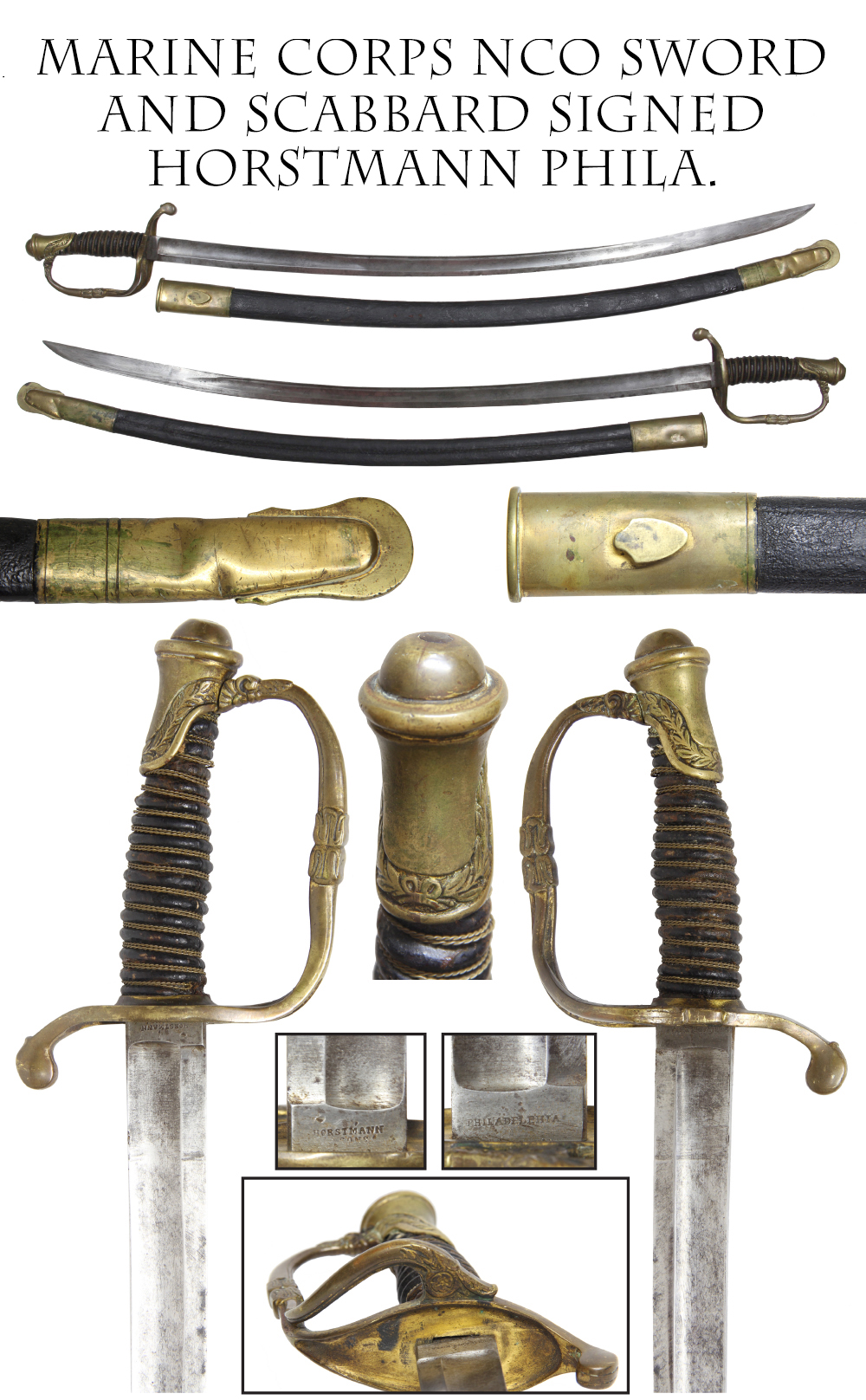
18-11-17 … CIVIL WAR US MARINE CORPS NCO SWORD (?) AND SCABBARD SIGNED HORSTMANN PHILA.:
The 1859 USMC regulations specified a sword for Marine sergeants that was similar to the army’s foot officer’s sword. The salient difference was that the scabbard had only two mounts, like these: one upper mount with a stud for a frog, and long, lower drag. This sword is made and marked by Horstmann and Sons, Philadelphia, who had USMC sword contracts in 1859 and 1861 and certainly provided them on a commercial basis as well. This sword follows the USMC sergeant’s specifications in having an un-etched blade and it has the narrower guard as specified in the 1861 USMC contract. In addition, this sword has an added short branch on the guard like the French pattern 1821 infantry swords. This branch is NOT called for on the USMC specs, but is frequently seen on Horstmann marked swords since Horstmann imported much of its sword components from the continent. Whether the USMC accepted these swords with the extra branch I cannot say. It is either a non-reg Civil War foot officer’s sword sold commercially, or a Civil War USMC sergeant’s sword with a variant branch in the guard. The blade is plain, as is specified by USMC. It retains some of the cross polishing at the ricasso, and has a good edge and point. The black leather scabbard is complete, solid with no breaks and decent finish. The drag has some dings. The throat is fine. The leather wrapped grip is excellent and still has its binding wires in place. A very nice example of a scarce and desirable sword.
$595.00
cejfrtz sold
Call us @ 419-842-1863
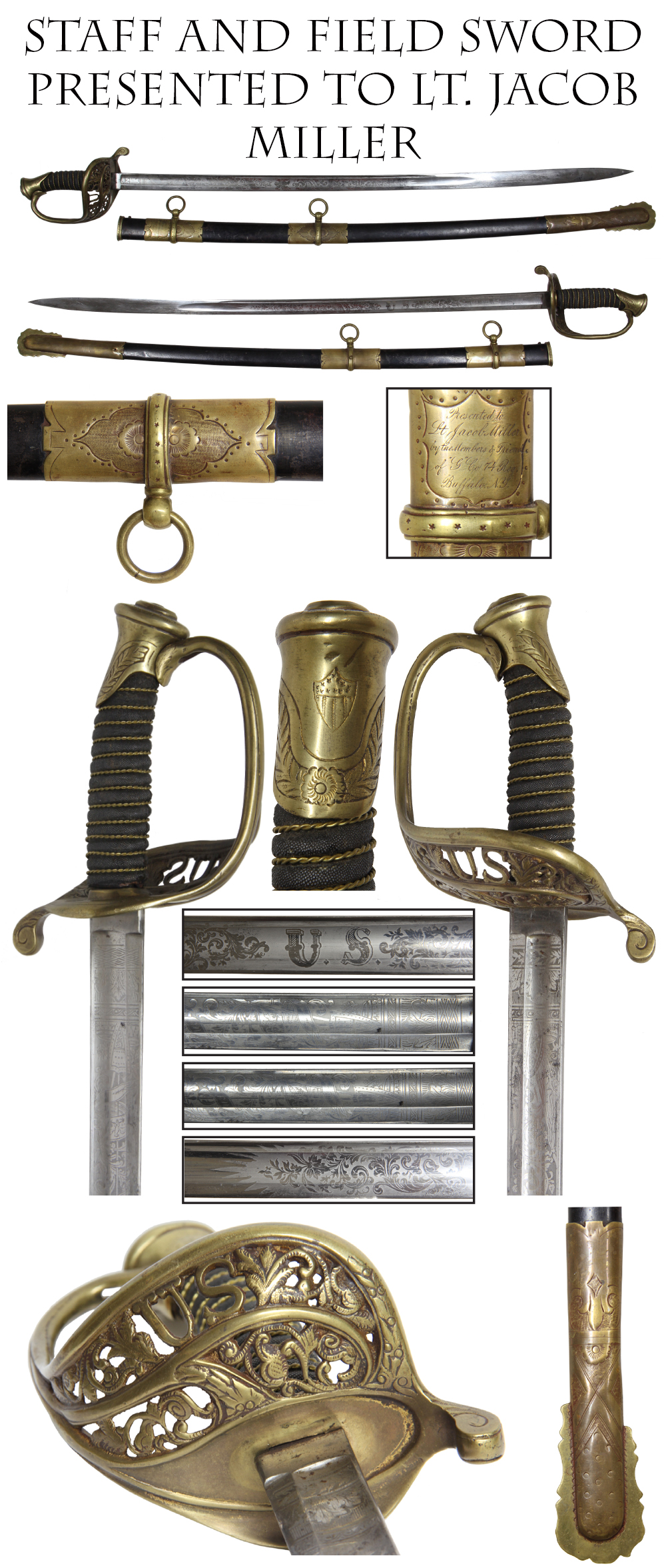
18-11-18… STAFF AND FIELD SWORD PRESENTED TO LT. JACOB MILLER….
Regulation 1850 pattern sword for field and staff officers. These swords were similar to the foot officer patterns, but since their owners were expected to serve mounted, the swords were longer and provided with more robust steel scabbards. This one is in impressive condition. The scabbard body still bears about all of its original blue and the brass scabbard mounts have a medium age patina that sets off their profuse engraving. The brass hilt matches in patina and has its full gray, sharkskin or rayskin wrap and twisted brass binding wire in place. The open work guard has the regulation cut-out US amid floral motifs that match the blade etching, which is vivid, with lots of the original frosted background setting off the entwined etched floral and military designs and a bold US. This is an impressive officer’s sword and bears its original presentation inscription on the upper mount: “Presented to/ Lt. Jacob Miller / by the Members & Friends / of “G” Co 74 Reg / Buffalo NY” This was the 74th Regiment New York National Guard. They were federalized for two tours of duty in 1863, one a thirty day tour during the Gettysburg campaign, during which they participated in one skirmish. Miller’s name, however, does not show up in the NY rosters, so he either joined the unit later or was not one of those who mustered into US service. In any case, he must have been well thought of. This is an impressive presentation sword. ….ab …
$1,950.00
Call us @ 419-842-1863
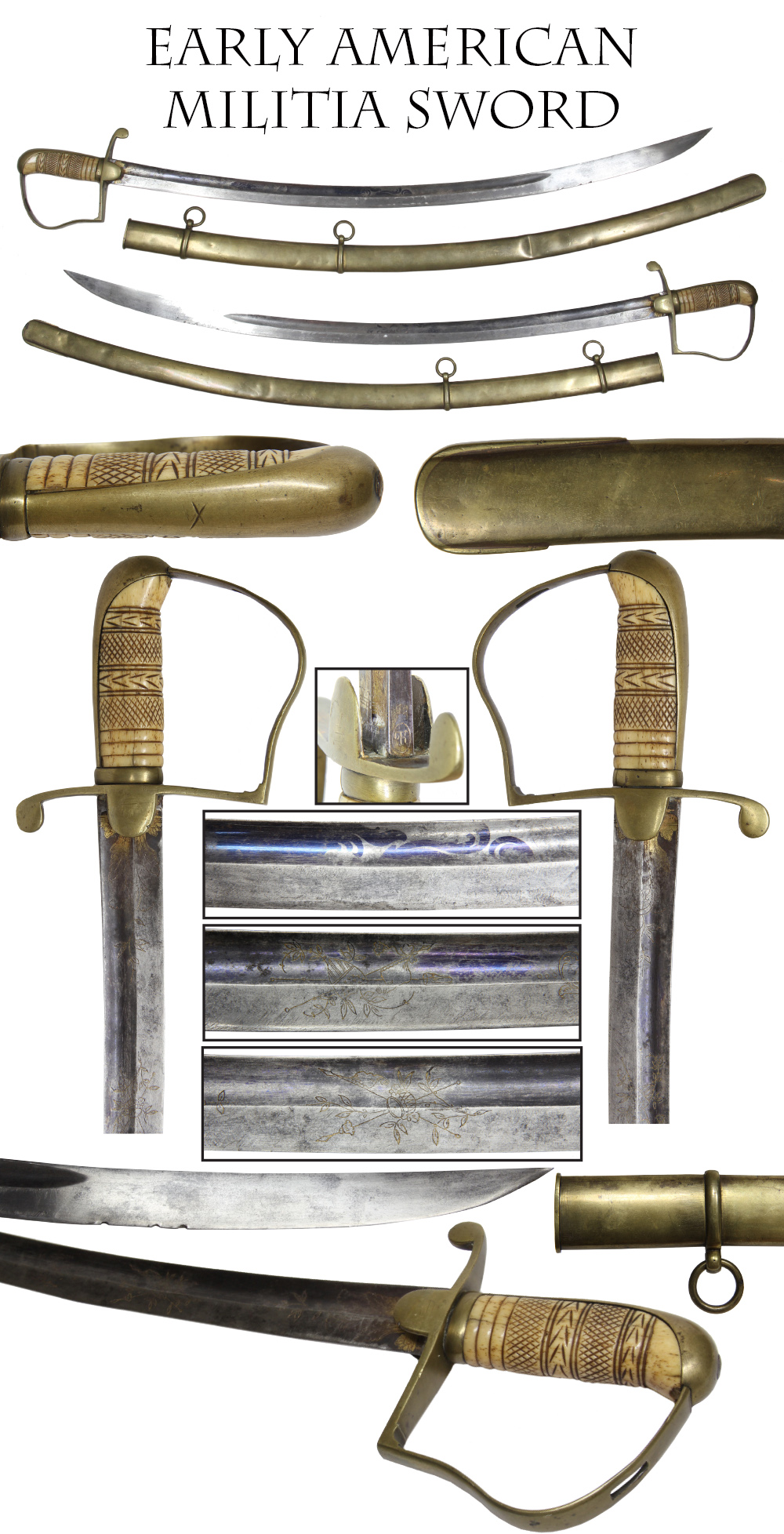
18-11-19… EARLY AMERICAN MILITIA SWORD:
Circa 1835 brass hilted saber with reverse-P guard, backstrap and langets, with its original and matching brass scabbard. The bone grip has a nice, cream colored patina with checkered designs. Nice and tight, with just some scattered brown marks and one, tight short hairline at the ferrule. The blade is bright mixed with gray, with some thin blue still showing in wide fuller that runs below the back edge and some gilt that still shows in the engraved martial designs that include an American shield, and is stronger in the small protected spots under the langets. There are three minor nicks to the blade edge near the point. Otherwise, edge and point are good. The scabbard has a few dings between the lower mount and drag. Drag, rings and throat are present. There is a small X on the backstrap. I don’t know what it signifies, and a small makers mark is visible stamped on the back edge of the blade where it meets the guard. Looks like a script K in an oval. Brass mounted swords are often classed across the board as artillery sabers since yellow was specified as a mounting color for that branch of service, but the fact is that anyone could order one and in the militia the specifications could vary by company. 34 inches overall length. Very handsome and very affordable.
$695.00
Call us @ 419-842-1863

18-11-20 … MINTY NCO SWORD DATED 1863:
Beautiful condition Civil War sergeant’s sword dated 1863, made by Emerson and Silver of Trenton, NJ, complete with its proper E&S steel scabbard. Vividly bright blade with no pits, rust, or edge nicks, and a good point. Very pleasing mellow patina to the brass hilt and scabbard mounts. The scabbard is minty as well, with no dings or dents, and still bears its full blued finish with a few tiny age freckles. Very clear US, DFM inspector and 1863 date stamps on one side of the ricasso and the Emerson and Silver stamps on the other side. Emerson and Silver were ahead of their time in using metal scabbards and collectors have always favored them, as the soldiers likely did also- no chance of breaking them through careless handling. The tradition of arming sergeants with swords as a badge of rank was an old one and NCO swords are a key part of any US edged weapons or Civil War collection. This is as nice as I have seen in recent years. The steel scabbard makes the Emerson & Silver swords suitable for careful use in living history. A dandy overall length 38 inches…
$595.00
Call us @ 419-842-1863

18-11-21… NCO SWORD MADE BY AMES DATED 1864….
Among collectors the Ames company is perhaps the best known supplier of edged weapons in the Civil War. Here is an example of their NCO sword made in 1864, with nice U.S., George W. Chapin Armory Sub-inspector “G.W.C.” stamp, and an 1864 manufacture date on one side of the ricasso, and the Ames Mfg. Co. / Chicopee scroll logo on the other. The blade is a mix of bright and light, steel gray, with no edge nicks or chips, no rust, and a good point, still with its thin leather pad on the underside of the guard to seal the scabbard. Small subinspector marks JH and CSD also appear on the brass hilt, which has a nice, mellow, un-messed-with patina. No scabbard, but a very good example by a well-known maker with a wartime date. 38 inches overall.
$275.00
Call us @ 419-842-1863
Layaways are Welcome
Need to split your order into multiple payments? No problem! A simple 20% earnest money deposit will hold your item for you.-acf
You can then pay it off in easy installments that fit your budget.
Read Terms Here
Items to Sell? Contact Us
I am always interested in buying ANYTHING from the American Civil War… Guns, Swords, Civil War Muskets, Knives, Uniforms, Flags, Medals, Badges, Diaries, Letters, Autographs, Buttons, photographs, tintypes, daguerreotypes, Insignia, Camp Items, Battlefield Relics, canteens, Drums, Etc… Call 419-842-1863 and ask for Dave Taylor.

